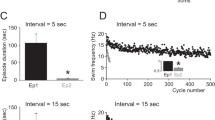Abstract
To extend our understanding of the network-based properties which enable a neuronal circuit to produce sustained electrical oscillations, we explored the potential contribution of metabotropic glutamate receptors (mGluRs) to generation of rhythmic discharges. The in vitro spinal cord of the neonatal rat was used as a model to find out if electrical patterns characterized by either alternating or synchronous motor pool discharges (recorded from lumbar ventral roots) required mGluR activation or were modulated by it. Alternating patterns of fictive locomotion (induced by NMDA and 5HT) were slowed down and blocked by the broad spectrum mGluR agonist (±)-1-aminocyclopentane-trans-1, 3-dicarboxylic acid (t-ACPD; 5–50 μM) and unaffected by the broad spectrum mGluR antagonist (RS)-α-methyl-4-carboxyphenylglycine (MCPG; 1 mM). The regular, synchronous bursting emerging in the presence of strychnine and bicuculline was accelerated by t-ACPD with a commensurate decrease in single burst length, an effect antagonized by MCPG which per se did not affect bursting. The action of t-ACPD was selectively inhibited by the L-type Ca2+ blocker nifedipine which, however, did not change rhythm acceleration evoked by NMDA. These data suggest that neither alternating nor synchronous oscillatory discharges were apparently dependent on mGluR activation via endogenously released glutamate. However, mGluR activation by the agonist t-ACPD modulated rhythmic patterns, indicating that such receptors are a potential target for pharmacological up- or downregulation of spinal rhythmicity.



Similar content being viewed by others
References
Alvarez FJ, Villalba RM, Carr PA, Grandes P, Somohano PM (2000) Differential distribution of metabotropic glutamate receptors 1a, 1b, and 5 in the rat spinal cord. J Comp Neurol 422:464–487
Beato M, Nistri A (1999) Interaction between disinhibited bursting and fictive locomotor patterns in the rat isolated spinal cord. J Neurophysiol 82:2029–2038
Bleakman D, Rusin KI, Chard PS, Glaum SR, Miller RJ (1992) Metabotropic glutamate receptors potentiate ionotropic glutamate responses in the rat dorsal horn. Mol Pharmacol 42:192–196
Boxall SJ, Thompson SW, Dray A, Dickenson AH, Urban L (1996) Metabotropic glutamate receptor activation contributes to nociceptive reflex activity in the rat spinal cord in vitro. Neuroscience 74:13–20
Bracci E, Ballerini L, Nistri A (1996) Spontaneous rhythmic bursts induced by pharmacological block of inhibition in lumbar motoneurons of the neonatal rat spinal cord. J Neurophysiol 75:640–647
Cao CQ, Evans RH, Headley PM, Udvarhelyi PM (1995) A comparison of the effects of selective metabotropic glutamate receptor agonists on synaptically evoked whole cell currents of rat spinal ventral horn neurones in vitro. Br J Pharmacol 115:1469–1474
Cerne R, Randic M (1992) Modulation of AMPA and NMDA responses in rat spinal dorsal horn neurons by trans-1-aminocyclopentane-1, 3-dicarboxylic acid. Neurosci Lett 144:180–184
Chen J, Heinke B, Sandkuhler J (2000) Activation of group I metabotropic glutamate receptors induces long-term depression at sensory synapses in superficial spinal dorsal horn. Neuropharmacology 39:2231–2243
Conquet F, Bashir ZI, Davies CH, Daniel H, Ferraguti F, Bordi F, Franz-Bacon K, Reggiani A, Matarese V, Conde F (1994) Motor deficit and impairment of synaptic plasticity in mice lacking mGluR1. Nature 372:237–243
Darbon P, Scicluna L, Tscherter A, Streit J (2002) Mechanisms controlling bursting activity induced by disinhibition in spinal cord networks. Eur J Neurosci 15:671–683
Dong XW, Morin D, Feldman JL (1996) Multiple actions of 1S, 3R-ACPD in modulating endogenous synaptic transmission to spinal respiratory motoneurons. J Neurosci 16:4971–4982
El Manira QA, Kettunen P, Hess D, Krieger P (2002) Metabotropic glutamate receptors provide intrinsic modulation of the lamprey locomotor network. Brain Res Rev 40:9–18
Grillner S, Wallen P (1999) On the cellular bases of vertebrate locomotion. Prog Brain Res 123:297–309
Jia H, Rustioni A, Valtschanoff JG (1999) Metabotropic glutamate receptors in superficial laminae of the rat dorsal horn. J Comp Neurol 410:627–642
Jones MW, Headley PM (1995) Interactions between metabotropic and ionotropic glutamate receptor agonists in the rat spinal cord in vivo. Neuropharmacology 34:1025–1031
Kiehn O, Kjaerulff O (1998) Distribution of central pattern generators for rhythmic motor outputs in the spinal cord of limbed vertebrates. Ann N Y Acad Sci 860:110–129
King AE, Liu XH (1996) Dual action of metabotropic glutamate receptor agonists on neuronal excitability and synaptic transmission in spinal ventral horn neurons in vitro. Neuropharmacology 35:1673–1680
Morisset V, Nagy F (1996) Modulation of regenerative membrane properties by stimulation of metabotropic glutamate receptors in rat deep dorsal horn neurons. J Neurophysiol 76:2794–2798
Rekling JC, Funk GD, Bayliss DA, Dong XM, Feldman JL (2000) Synaptic control of motoneuronal excitability. Physiol Rev 80:767–852
Rozzo A, Ballerini L, Abbate G, Nistri A (2002) Experimental and modeling studies of novel bursts induced by blocking Na+ pump and synaptic inhibition in the rat spinal cord. J Neurophysiol 88:676–691
Russo RE, Nagy F, Hounsgaard J (1997) Modulation of plateau properties in dorsal horn neurones in a slice preparation of the turtle spinal cord. J Physiol 499:459–474
Schoepp DD, Jane DE, Monn JA (1999) Pharmacological agents acting at subtypes of metabotropic glutamate receptors. Neuropharmacology 38:1431–1476
Tscherter A, Heuschkel MO, Renaud P, Streit J (2001) Spatiotemporal characterization of rhythmic activity in rat spinal cord slice cultures. Eur J Neurosci 14:179–190
Ugolini A, Corsi M, Bordi F (1997) Potentiation of NMDA and AMPA responses by group I mGluR in spinal cord motoneurons. Neuropharmacology 36:1047–1055
Acknowledgements
This work was supported by grants from MIUR (FIRB and COFIN) and INFM.
Author information
Authors and Affiliations
Corresponding author
Additional information
The first two authors contributed equally to this work
Rights and permissions
About this article
Cite this article
Taccola, G., Marchetti, C. & Nistri, A. Effect of metabotropic glutamate receptor activity on rhythmic discharges of the neonatal rat spinal cord in vitro. Exp Brain Res 153, 388–393 (2003). https://doi.org/10.1007/s00221-003-1668-1
Received:
Accepted:
Published:
Issue Date:
DOI: https://doi.org/10.1007/s00221-003-1668-1




